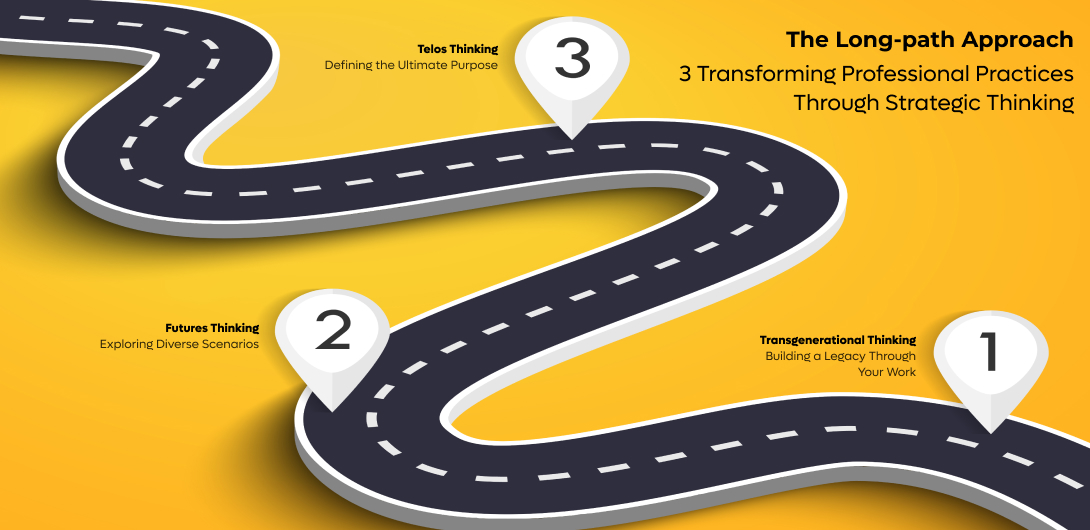In today’s fast-paced professional environment, where immediate results often overshadow long-term objectives, individuals frequently struggle to balance short-term demands with enduring success. The concept of long-path thinking offers a transformative framework to address this challenge, enabling professionals to move beyond short-termism and embrace sustainable, impactful practices. Long-path thinking encompasses three core components: transgenerational thinking, futures thinking, and telos thinking. Let’s explore how these principles can reshape the way professionals approach their work.
1. Transgenerational Thinking: Building a Legacy Through Your Work
Transgenerational thinking emphasizes extending the time horizon of decision-making beyond immediate outcomes to consider the impact on future generations. This approach encourages professionals to view their contributions not just as tasks to complete but as steps toward creating a lasting legacy.
Practical Application for Professionals:
- Leadership and Mentorship: Cultivate future leaders by mentoring junior colleagues, ensuring the continuity of institutional knowledge and fostering a culture of growth. For example, a senior engineer mentoring a junior team member ensures that best practices and technical expertise are passed down, contributing to the organization’s long-term success.
- Sustainable Practices: In decision-making, prioritize long-term benefits for clients, employees, and stakeholders, even if it requires short-term sacrifices. For instance, a company opting for renewable energy solutions in its operations may incur higher initial costs but ensures sustainability for future generations.
By adopting a transgenerational mindset, professionals create value that endures, ensuring their efforts support not just immediate goals but also future progress.
2. Futures Thinking: Exploring Diverse Scenarios
Futures thinking challenges the traditional, linear approach to planning by considering multiple potential outcomes and diverse scenarios. It moves beyond relying solely on current trends or technological fixes and encourages professionals to integrate ethical, cultural, and societal dimensions into their strategies.
Practical Application for Professionals:
- Strategic Career Planning: Envision multiple career paths and prepare for evolving industry trends by acquiring new skills and building resilience. For example, a marketing professional might learn data analytics and AI tools to remain relevant in a rapidly changing field.
- Risk Management: Anticipate changes in your industry or organization by considering various future scenarios, such as economic shifts or technological disruptions, and prepare accordingly. A financial advisor, for instance, might create diverse investment portfolios that account for potential market downturns.
By engaging in futures thinking, professionals position themselves to tackle complex challenges with a holistic perspective, fostering innovation and adaptability.
3. Telos Thinking: Defining the Ultimate Purpose
Telos thinking, rooted in the Greek concept of “ultimate aim,” urges professionals to ask, “To what end?” This principle focuses on aligning actions with overarching goals and ensuring efforts contribute to meaningful and sustainable outcomes.
Practical Application for Professionals:
- Purpose-Driven Initiatives: Align projects and initiatives with your core values and long-term professional goals to ensure they create meaningful impact. For example, a healthcare professional focusing on preventative care initiatives can improve patient outcomes and reduce long-term healthcare costs.
- Client and Stakeholder Engagement: Regularly ask how your work contributes to the broader goals of your clients, organization, or community to maintain alignment and focus. A consultant might focus on delivering solutions that not only solve immediate problems but also enable clients to build internal capabilities for the future.
Telos thinking inspires professionals to move beyond transactional objectives, such as meeting deadlines or quotas, to focus on the broader purpose and value of their work.
Integrating Long-path Thinking in Professional Practices
To effectively implement long-path thinking, professionals can:
- Adopt a Practice Mindset: Long-path is not a one-time exercise but a continuous practice. Revisit these principles regularly to refine strategies and decision-making.
- Leverage Mentorship and Collaboration: Engage with mentors and cross-disciplinary teams to gain diverse perspectives and insights.
- Communicate the Vision: Clearly articulate long-term goals and purpose to colleagues, clients, and stakeholders, ensuring alignment and sustained support.
- Invest in Personal Development: Equip yourself with the skills and resources needed to adopt long-path principles, such as scenario planning and impact assessments.
Conclusion
The challenges faced by professionals today—ranging from resource constraints to rapidly shifting priorities—require a shift in thinking. By embracing transgenerational thinking, futures thinking, and telos thinking, professionals can transcend short-termism and drive meaningful, lasting change. The long-path approach not only enhances outcomes but also ensures that the work we do today lays a solid foundation for a better future.
The question for professionals to consider is: What is your long-path? How will the work you do today shape the future for generations to come? By adopting this transformative mindset, you can redefine success and leave an enduring legacy.








